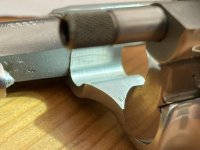The cause of the frame crack is somewhat of a mystery with several possible causes. It could be metallurgy or overpressured ammunition or barrel over-tightening or design. Whatever the cause, there is no way to repair a crack. Whether it is safe to continue firing a revolver having a crack has not been addressed that I know of. At least to me, the cause is irrelevant and the best approach is prevention by avoiding all revolvers having alloy frames, even though the probability of experiencing a frame crack in any specific revolver may be minuscule. Why take any chances?


